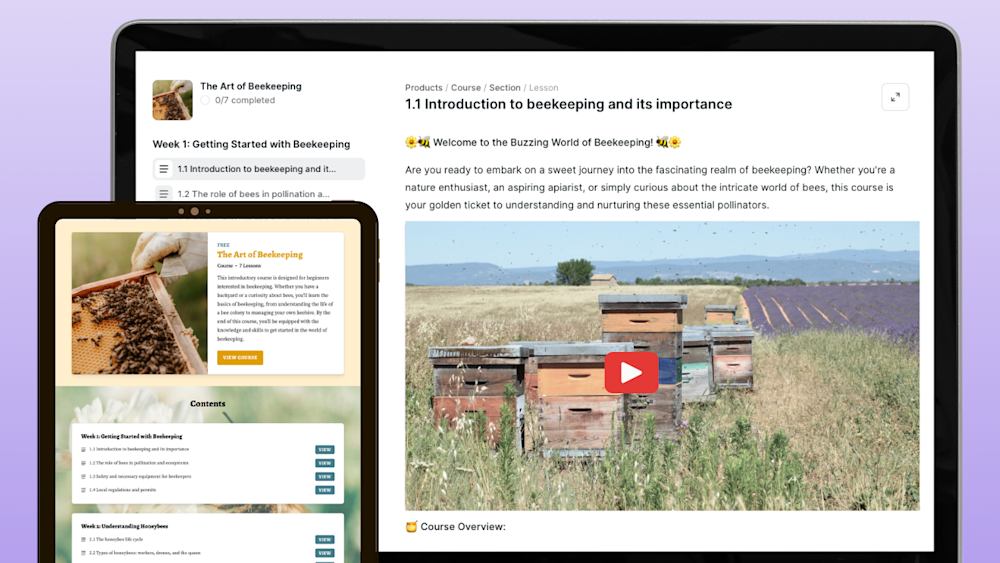Bottom line, here’s the data on online course pricing
Wait, who starts an article with a bottom line? It’s a fair question but hear me out: I know you’re busy and you probably came here looking for an average online course price point to set your own price.
So, let’s not mince words and get you what you need to sell online courses. We looked at 130,000+ online courses, and this is what we found out about pricing.
The average course price
Here’s the top-level data on online course prices:
-
Out of 132,009 course sales, the average course price is $137.
-
Out of the same cohort, the standard deviation for online course prices, which measures how spread apart the data is from the center, is 167.
What these two pieces of data tell us is a little more complex than it looks at a glance, but take heart, it’s not much. The standard deviation here is high, which means there’s a lot of variability in the data and we can’t rely on our average for everything, but it’s not too high to be useful.
To give you an idea, SAT scores, which are a standardized test for students seeking college admission, have a higher standard deviation of 211 points.
For pragmatic purposes, what this means is that most online courses fall within 167 points of the average on either side. Since we’re talking about money and no one is selling a course that requires them to pay their customers, we can condense these data points into this statement:
-
The range of average online course prices runs from $0 to $304.
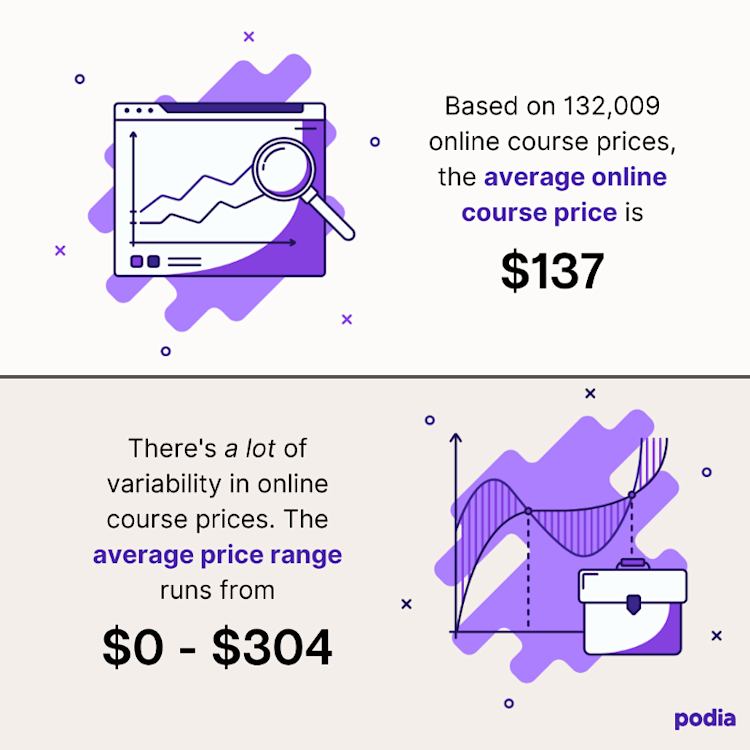
And now you’re probably thinking: “Great. That helps me zero, that’s a huge range.”
While it’s not as neat and tidy as our straight average, there are other data points below that make that range even narrower, which we’ll go into later.
The gist of our insight, though, is that we recommend $100 as a starting price for new creators.
Does that number sound too high to you?
$100 isn’t risky, even if it feels like it is because you’ve never sold a product online before. It’s not so high that it’s inaccessible to most customers, but it’s not so low that you’re guaranteed to lose money on it without a Titanic-sized boat of sales.
Alternatively, if you’re not a new creator and you’re trying to price your next course, this range is a green light for raising the price of your course over that $100 mark.
Based on our range, customers are used to seeing courses go up to $300 and then some. In fact, 89% of all online course prices are $350 or less.
So if you’ve already laid the groundwork to build an engaged audience, why not test prices higher than the average range? I wouldn’t suggest going wild but consider at least experimenting with the boundaries of your normal prices.
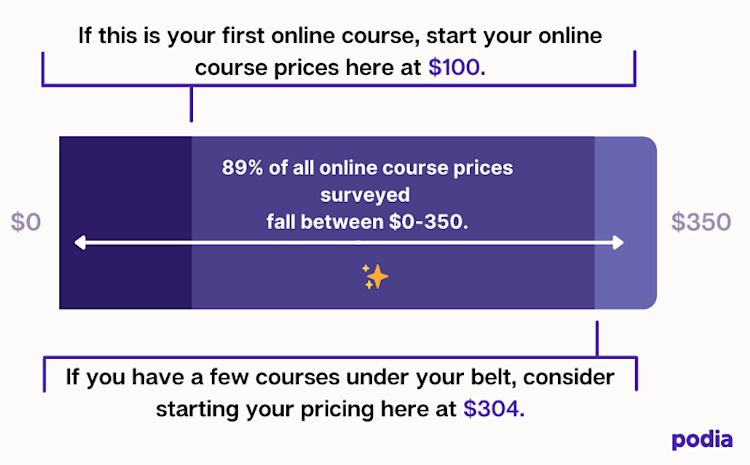
There’s nothing stopping you from changing them later on and re-launching if it doesn’t work. If it does, though, you’ll have an entirely new insight into your audience’s willingness to financially support your business, and a hopefully much cozier take-home profit for it.
And if you keep making more courses that sell for that much, that’s all the better. Speaking of, how many online courses should you plan to create if you want to follow the market?
The average number of courses
This is what we found out about the average number of courses:
-
Out of 18,133 creators sampled, the average number of online courses is 13.
-
Conversely, the median number of courses per creator is 6.
-
The mode, which is the most commonly repeated number in a data set, is 1.
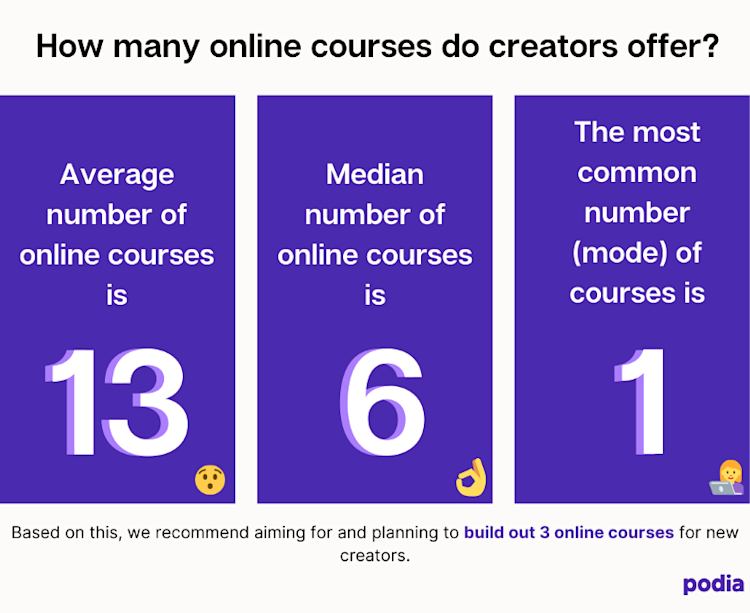
All of these numbers are useful, though the second is probably truer for us. Basically, while many creators have a handful of courses — around six — there are many more creators who have just one course.
Likewise, there are a lot of creators who have more courses than you can count on two hands (or four).
Erring to caution, aim to build up to three and see how far that takes you. Quantity of courses has no current correlation with success — the best growth rate is the one that’s sustainable for you.
The average course price of a creator’s first online course
This is what we learned about creators’ first online course sales specifically:
-
Out of 12,818 creators, the average price of a creator’s first online course sale is $157.
-
The median selling price of a creator’s first online course is $89.
-
The mode value of a creator’s first online course price is $97.
-
The standard deviation for an online creator’s first course price is 185.
Yikes, that’s a lot of numbers, right? Because our dataset is so spread out and covers creators in every niche, there’s no clean average here, either.
But with the mode and median being so close together, we can confidently say (again) that most online course prices fall close to $100, even for first-time creators.
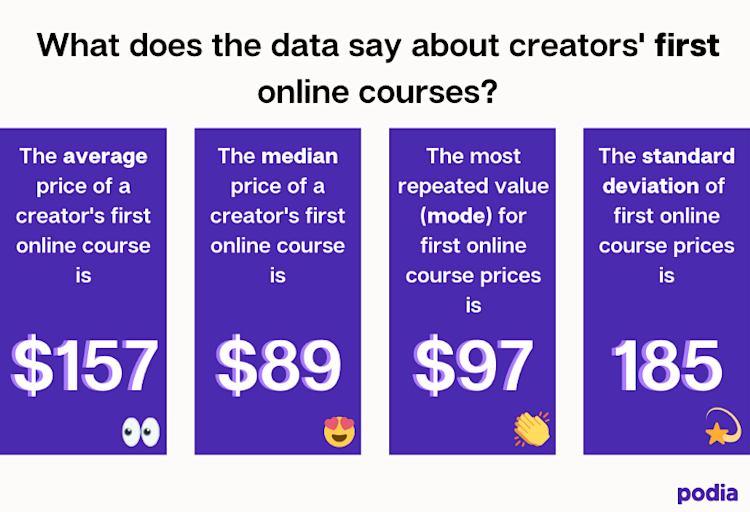
But let’s get the full picture here. What’s the shape of the data? There’s good news and bad news.
The probability of online course prices (or prices by cohorts)
When we look at the price cohorts, or cluster our pricing together by $50 increments to see how much space they own in the data set, the shape of the data tells us a lot.
Here it is in a bar graph:
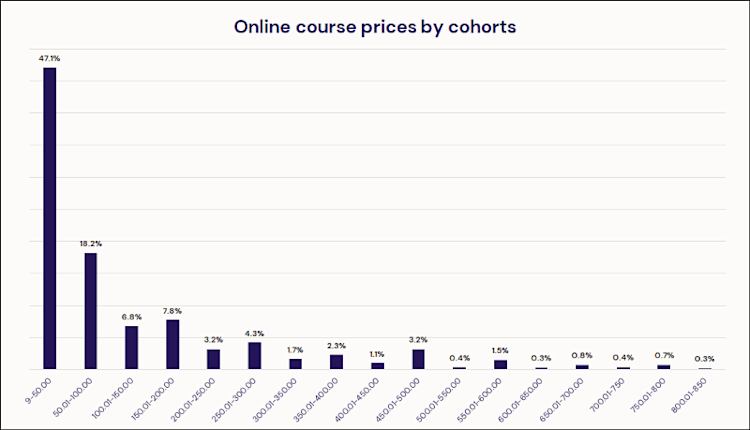
47.1% of creators surveyed are charging $50 or less for their courses.
Combined with the second biggest cohort, 65% of online courses are $100 or less.
That first number — the 47.1% — is a little concerning. For mini-courses, and that might indeed be what they were as our data made no distinction, that’s a more than reasonable price point.
But if you’ve spent weeks building, polishing, and losing sleep on your online course and feel tempted to join the 47.1% and set your course price at $50, I’d encourage you to reconsider.
Setting your price point too low could impact the perceived value of your course, which is the way your customers look at the desirability of your product, consciously and otherwise.
More importantly, it requires twice as much work from you to get half as many profits. If you want to make $1000 off your online course in a week, you can either convince 10 people to pay $100, or 100 to pay $10.
The former is much easier.
Here’s another way we can look at the distribution of online course pricing data. It’s illustrating the same principle as the bar chart, but it shows us how likely we are to find a given value, or the probability of its distribution.
The solid line is your price point clusters, scaled out enough to give us a nice shape to visualize, and the dotted line is the linear trend line.
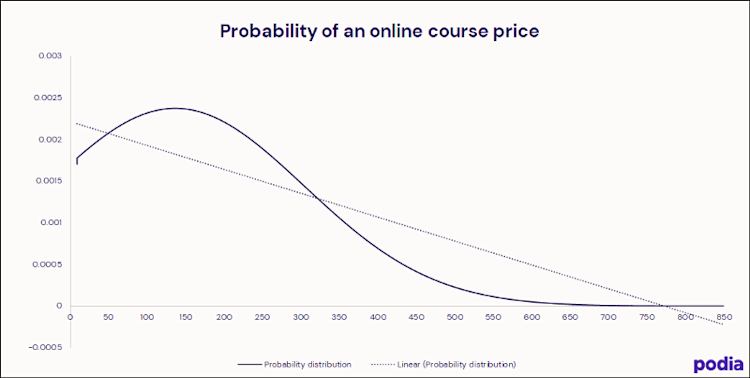
It’s basically one big tidal wave. Online course prices start to build up and peak early on around the ~$100-$200 range and then descend smoothly down until $600-$650 and flatten out.
So, batting for $100 and $250 is very doable, and more importantly, it’s being done today. Next, let’s look at how long it’s taking creators to sell their courses once they join Podia.
The average time between a creator signing up and making their first sale
Here’s the truth:
Not everyone is successful at this. (But everyone can be.)
For most creators, it comes down to the first month.
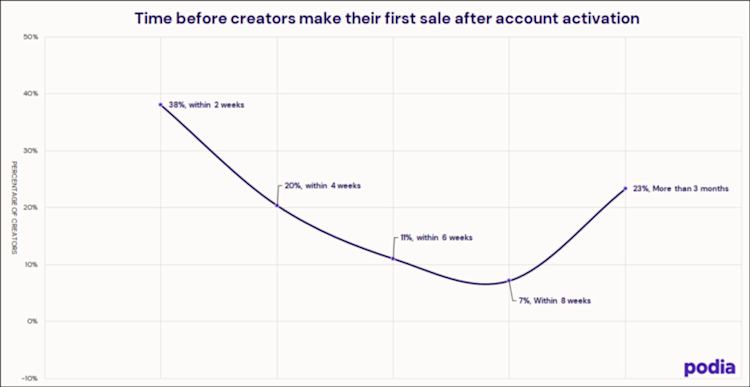
-
38% of creators make their first sale within two weeks.
-
20% make their first online sale within four weeks.
Combined, that means 58% of creators who make a sale on Podia do so in their first month after joining. The rest of the numbers are:
-
11% of creators sell their first online course on Podia within six weeks.
-
7% of online courses sell for the first time in 8 weeks.
-
23% of creators sell their first online course on Podia after 3+ months.
So, this begs the obvious question.
How do you end up in that first group and sell your online course for the first time within a month of launching? Or, if you’re part of the 23% of creators who don’t make a sale until after three months, what do you do to get out of it?
For the latter, I highly recommend checking this resource out:
-
12 battle-tested online course launch tips I learned in the trenches — From fizzled course launches can come great things. Austin took us through the twelve things he learned after his first launch fell flat that made his second a success.
As for the former and making your first sale as soon as possible, there’s a lot of potential for conjecture here about why one group sells faster than the other. That said, this is what we’ve seen work:
-
Pre-launching your online course. This is when you collect email addresses of people committed to buy on launch day.
-
Pre-selling your online course. This is when you take pre-launching a step further and sell your course before it’s ever live, either in full or for a down payment.
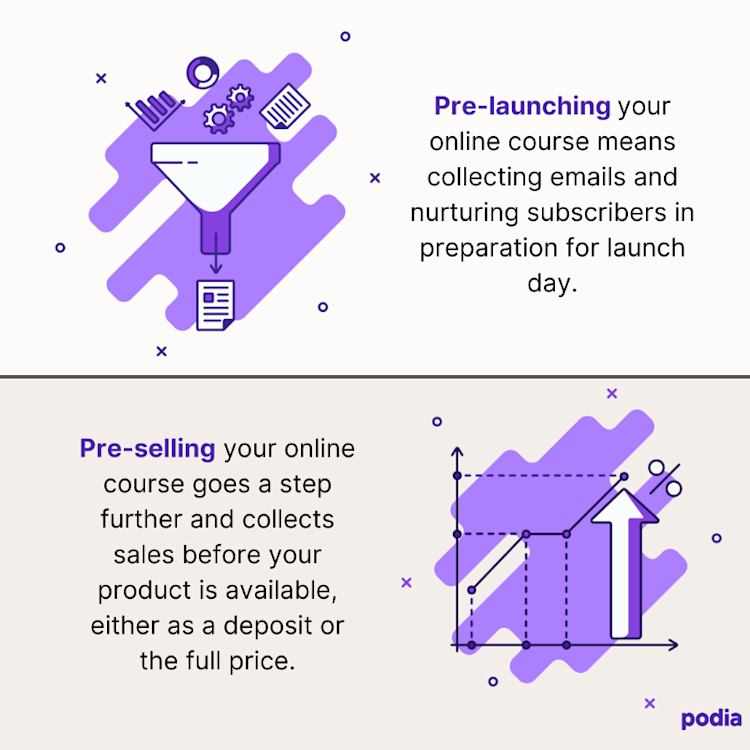
Both methods require most of their marketing and selling work leading up to your course launch, but then are low-to-no maintenance afterward. They can respectively be intense, but if you’re looking to make most of your profits quickly rather than over the long-term, it’s an option.
If that doesn’t sound like your speed, evergreen online course sales are the alternative. Or, if you want the hype of a big launch day and the potential for long-term gains, you can always combine them.
We wouldn’t recommend it for your first online course or using the product launch model generally as a fresh beginner. Instead, plan on evergreen sales and playing the long game. It’s easier, less immediately time-consuming, and gives you the space to walk before you run.
The creators we talk about in our next section are giving their customers that same chance, too.
How many creators are offering payment plans
Payment plans, which allow your customers to pay for your online course over time and can lower the barrier to entry, made a respectable showing in our analysis. Check it out:
-
Out of 14,617 creators, 3062 offered payment plans.
-
Put into percentages, this means 21% of course creators sampled use payment plans to lower the upfront cost of their course.
We’re big advocates for payment plans here at Podia — it’s why we make them so easy to offer your potential customers — but it doesn’t always make sense for an online course.
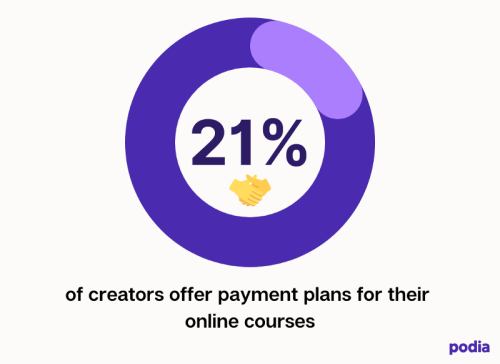
If you’re trying to decide whether to use payment plans as part of your pricing strategy, we recommend only offering them for online courses that are $99 or more.
There’s a non-zero chance that a payment plan on a lower-priced course could hurt the perceived value of your product, just like a too-low price or discount can. That’s not to say that you can’t — your niche may be different, and no one knows your audience better than you.
But, since all of our data indicates that the most common course price to find in the wild is at or under the $100 mark, you wouldn’t be charging more than your competitors or racing to the bottom line if you limited payment plans for your high dollar items.
Past that, remember how we said it’s easier to sell a $100 online course 10 times than a $10 course a hundred times? The same method goes here; if you have income goals, and I assume you do, you’re going to reach them a lot faster by collecting your dues upfront.
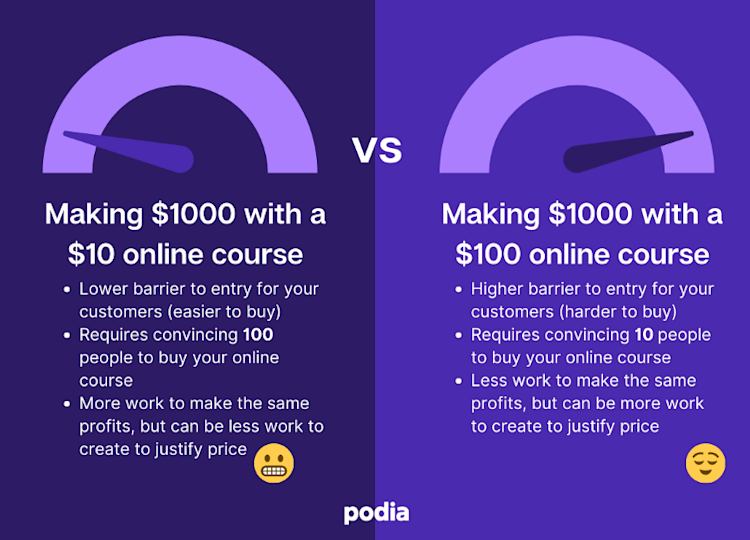
Think of payment plans as opening the door for more customers to access your online course. If it’s not also opening a door to making a living for you, it’s not a good fit. It needs to work for everyone.
A quick note about how we handled the data
For all measurements, we’ve looked at courses priced from $9-$850, which compromised 91% of our total original sample (145,000) and had the lowest data spread (~160 vs. ~1012). Our final data set was 132,009, and then divided into smaller sets as made sense for the question.
This was done to ensure we were giving price data that as closely reflected applicable reality as possible so you can act on it, and ideally, profit from it. The cliff between the top 10% of prices and bottom 90% is staggering, and the removed outliers appeared to largely be test products.
Or, if you look at it another way, we can say our data will be true 90% of the time for 90% of people.
This now concludes our analysis. If you want to explore what all of it means a little more and get more of your online course pricing questions answered, keep reading on. Otherwise, we’d love to send you more content like this in our weekly newsletter.
Sign up below to join our email list, and we hope this data helped you answer some questions. 🙂
Now that we’ve got that math out of the way and figured out where the data is, let’s wrap up with a few common pricing questions we see from our customers.
What to do if you’re trying to decide between different prices
You have income goals, but those don’t match up with what you think you should charge. Does this sound familiar?
Hopefully, you’re undecided between a high price and a higher price, but no matter what price point you’re struggling to decide on, the most important thing to do is validate it.
I’ll explain more on exactly how to validate a price in the next question, but the takeaway I want to impart here is that, ultimately, your decisions are only half of the pricing equation.
Your customers — new customers, old customers reacting to a price increase, and potential customers — are equally as responsible for setting your online course price.
If you set such a low price that your products look questionable compared to competitors, you won’t get the return you want for your course creation.
Likewise, if your price is so high that people are constantly comparing their learning experience to the cost of your course and finding it wanting, you’ll have unhappy customers on your hands.
Your price progression should look something like this:
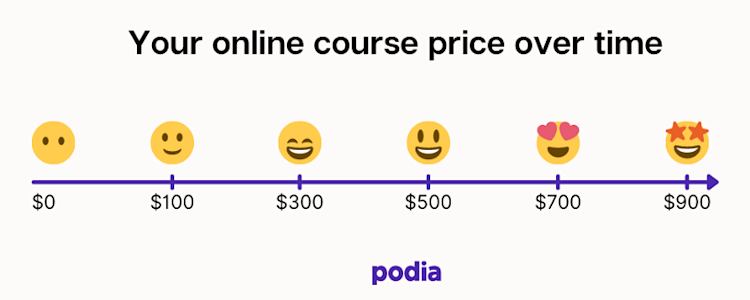
Finding your minimum and maximum price should be a conversation with your customers over the life of your business. Don’t undercharge for your course content, but too, listen to the wisdom of your audience.
If they tell you they won’t pay for it, or worse, demonstrate they won’t, believe them.
Happily, the same goes in reverse. This brings us to our next question.
How to validate your price with your target audience
Learners come in all shapes and sizes, but across audiences, their wallets and willingness to open them tends to be stable. Thus, the best way to check if your price point works for your audience is to ask them.
Yes. Really.
Something as simple as an ask on social media can do wonders. One of my favorite examples of this is John D Saunders, who told us about a unique strategy he uses to get early investors.
His proposition to his audience is simple. He tells them, “Hey, if you’re interested in enrolling, I’ll create a landing page for you to fill it out and pay $7.”
Those that take the offer receive a significant discount off the full price on launch day for his upcoming online course.
John explains a little more in this great tweet thread about creating high-quality online courses:
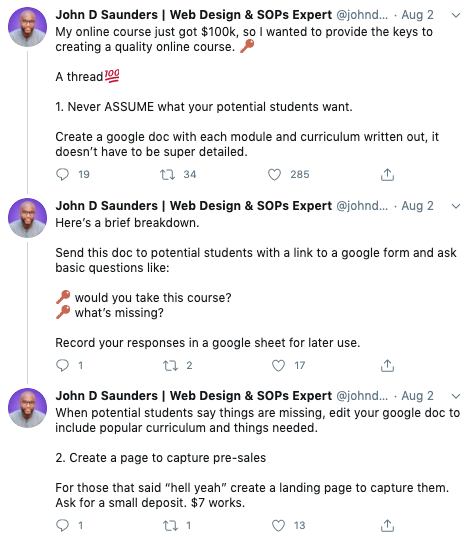
“It doesn’t have to be a huge community,” John told us when we had the privilege of interviewing him on his $100,000 sales milestone. “It could be 15 to 30 people, but it has to be your target audience.”
If you don’t already have a community of potential students to ask, check out these guides to finding your audience and building a relationship with them:
-
How to land your first 100 customers [Infographic + tutorial]
-
How to use a Facebook sales funnel to turn leads into loyal customers
Our Passion/Profit Matrix, which you can use to categorize course topic ideas and profitability depending on the answers you get back, can also help:
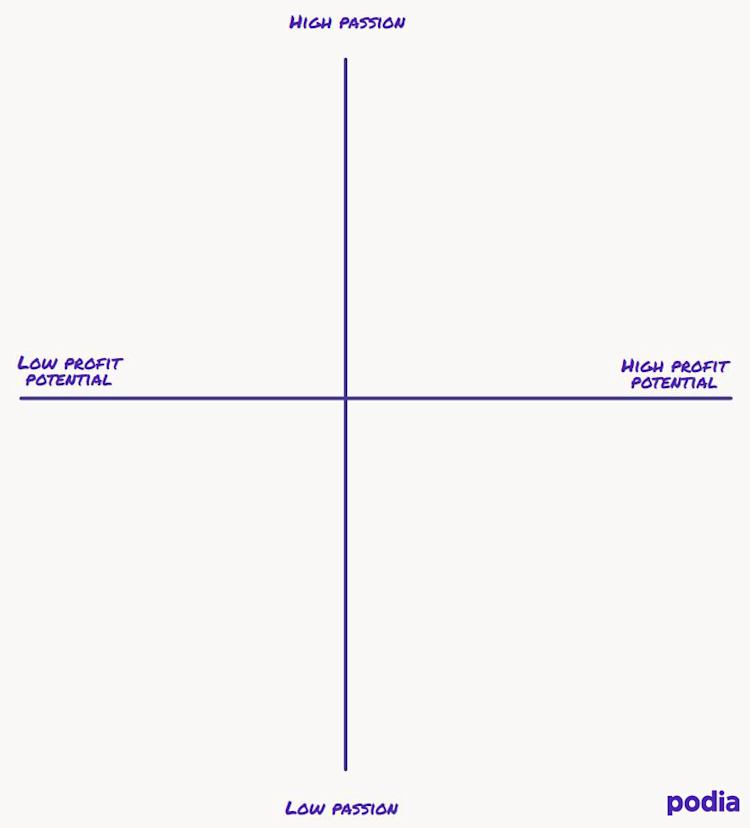
Otherwise, don’t be afraid to join Facebook groups to find your target audience and online course topic or dive into subreddits around your niche. Social media and forums are a great, free place to start building bridges with your audience and validating your product ideas.
Just mind their policies. Just as you wouldn’t want someone spamming your social spaces with constant sales pitches, neither do those communities. Get to know people, answer questions helpfully, and be an active listener whether you’re reading posts or talking in a group.
The more you give the group first, the better they’re likely to receive your pitch, and ultimately, your product.
Should you charge a low price or a premium price?
A higher price point has a lot of appeal, and we recommend that people start closer to $100 than further away, but different price tiers work for different creators.
Are you just starting out and your email list is a handful of friends and family? Then start low and slow and anchor your price around the median. Or, if you want to maximize your audience building so you can charge a pretty price tag later, consider creating a mini-course.
Email courses, which are usually the format mini-courses take, are a fantastic marketing strategy for new and veteran creators alike.
Reuven Lerner, veteran creator who turned his offline education business into an online platform, started with email courses to build up his audience and email list. He still offers free programming email courses to this day despite having many other courses now under his belt.

Beyond that, a premium price requires an equally premium marketing approach. The higher your price tag is, the harder enrollment will be to drive, whether your audience is brand new or has been a staple in your life for years.
At a minimum, we recommend investing in email marketing, whether you’re offering a free online course or a four-digit (or more!) course.
But especially for online courses with a premium price tag, you should be using your email list to promote, build case studies on your customers, and collect testimonials for your sales page.
Think of it this way — if you see a lemonade stand on the side of the road for a quarter, you probably won’t question why it’s that expensive. If you saw the same lemonade stand and they charged $25 a pop, you’d have a lot more questions before you buy.
Your customers want to know that your course content will live up to its fee. Help them see that in as many ways as possible.
In addition to testimonials for your landing page, one great way to increase the perceived value of your course is to include templates and worksheets (or workbooks) in addition to videos and text. Printables are an easy and often free-for-you way to add to the appeal of an online course.
(Go here for our guide to printables to get started on yours today.)
Other aspects that can help a premium price land include live Q&As, offered either during in-course webinars in the form of group meetings or as a special session on social media.
Lastly, there are also FAQs, which live on your sales page permanently and can do a lot to settle doubts.
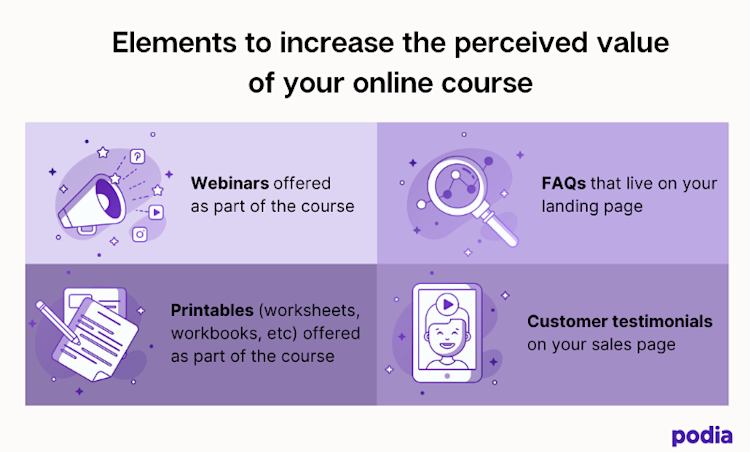
Note: We strongly recommend creating a clear refund policy before launching, particularly for creators aiming for the high-end of the market. You can include your refund policy in your FAQ and keep it short-and-sweet, just as you can see Reuven doing below:
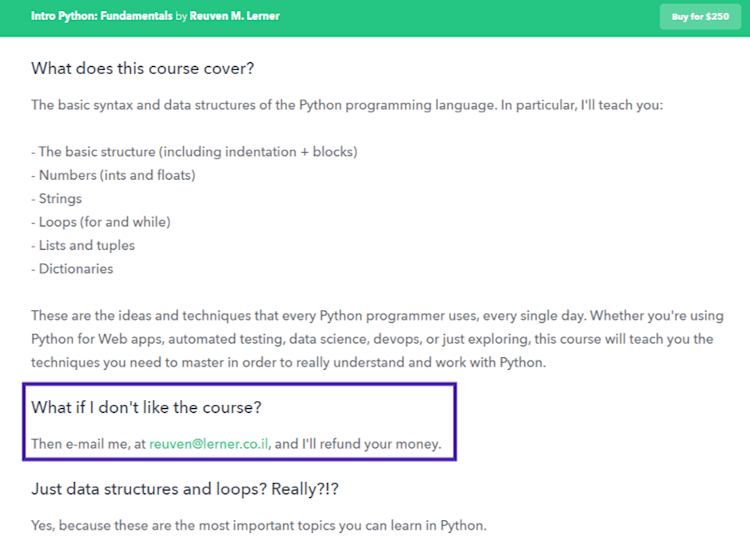
Or it can be vastly different. The point isn’t to create a perfect policy that offers refunds unflinchingly, only to have it available ASAP.
Specifically for creators charging a higher price, I recommend placing your refund policy up-front-and-center the way Reuven has in the above example. It’ll create peace of mind for both you and your customers to have it ready before any issues can arise.
If you’ve ever heard that an ounce of prevention is worth a pound of cure, that’s wholly true for providing customer service as a creator.
Plus, it’s a breeze to do on Podia. But don’t just take my word for it — try it for yourself with a free 30-day trial today.
(If you want to see how Podia stacks up against other online course platforms, you can read more reviews on imminentbusiness.com.)
How it all adds up
A bad pun notwithstanding, these are the most important insights into our data analysis, outside of the data itself:
-
$100 is the perfect starting price for an online course — and our pricing data backs that up.
-
Payment plans are offered for roughly every one out of five online courses. We recommend them for courses greater than or equal to $99.
-
Aim to grow your course portfolio over time. The median value of courses for creators is 6. The truth probably lies just north and south of that, so don’t compare yourself into joylessness. Three online courses should be plenty to mature your infopreneur business.
-
If you want to charge higher than the $100 recommendation, you need an audience that’s willing to pay it. The only way to find that out is to ask your target audience directly — and then plan to spend more time marketing to convince people to pay the premium.
-
The most important takeaway in this article is that there is no magical “right price” for your online course. The data demonstrates that online courses are as varied as the industries they’re found in. Start from $100, trust your instincts, and go from there.
And remember, if your first online course price doesn’t work for your audience, you can always change it. The only thing set in stone is the past. The future of your business is your show, your rules, and your prices.
Best of luck out there, and if you need any help selling your online courses, we’re only a message away. 🤝

